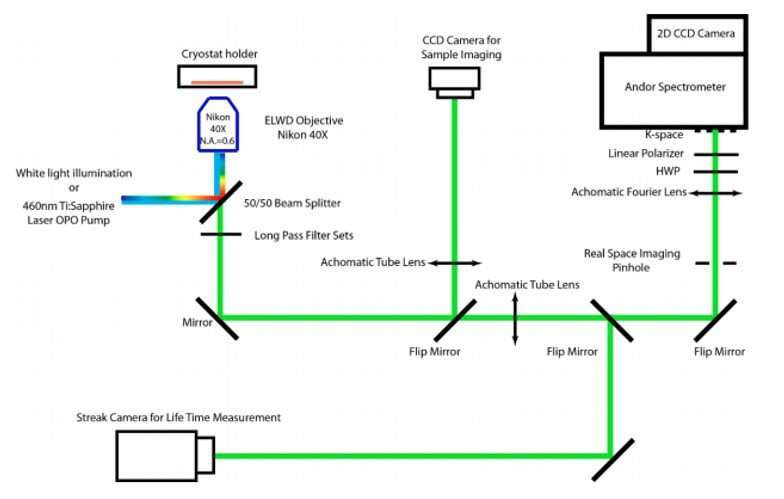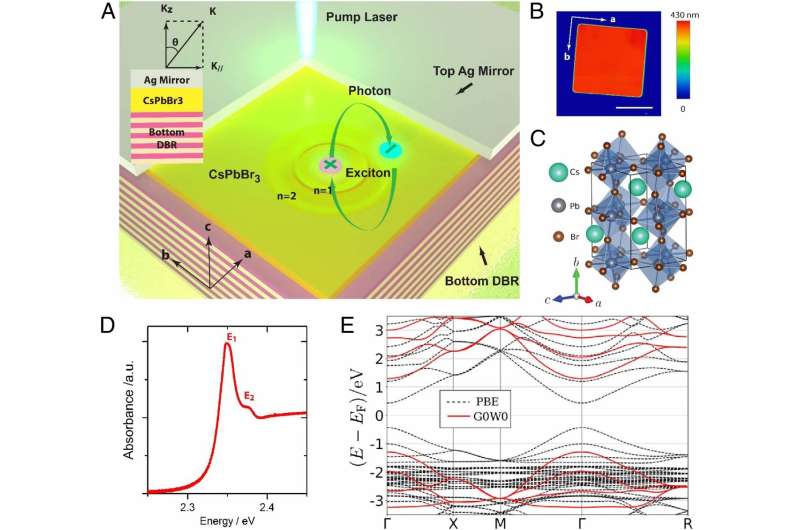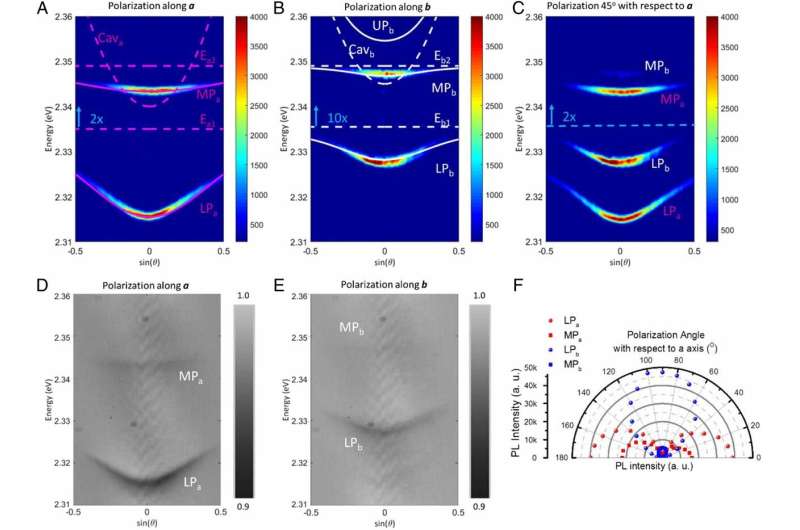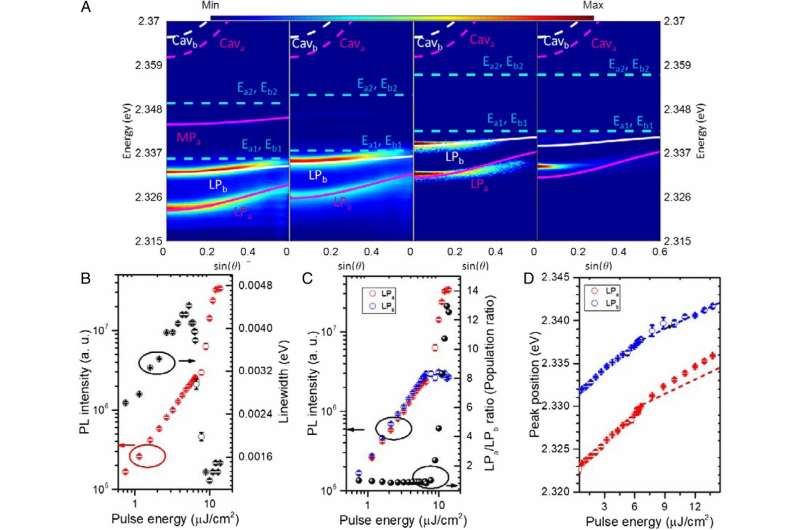Schematic of the home-built setup for laser characterization, lifetime measurement, and polarization-dependent k-space photoluminescence (PL) spectroscopy. Credit: Proceedings of the National Academy of Sciences (PNAS), doi: https://doi.org/10.1073/pnas.1909948116
In quantum physics, Rydberg excitons with high principal value can exhibit strong dipole-dipole interactions. However, polaritons (quasiparticles) with an excitonic constituent in an excited state, known as Rydberg exciton polaritons (REPs) remain to be experimentally observed. In a recent study now published on the Proceedings of the National Academy of Sciences of the United States of America (PNAS). Wei Bao and an interdisciplinary research team in the departments of physics, electronics and the National Science Foundation (NSF) Nanoscale Science and Engineering Center in the U.S., observed the formation of REPs in a single crystal CsPbBr3 (cesium lead bromide) perovskite cavity; without any external fields. The researchers noted the polaritons to exhibit strong nonlinear behavior, which lead to a coherent polariton condensate with a prominent blue shift. The REPs in CsPbBr3 cavity were highly anisotropic (showing different properties in different directions) with a large extinction ratio due to the orthorhombic crystal structure of the perovskite.
Quantum coherence is only possible in the presence of strong interactions between exciton polaritons due to their excitonic constituents. The observations by Bao et al. shed light on the importance of many-body physics in coherent polariton systems involving higher-order excited states and paves the way to explore additional coherent interactions. Further investigations will benefit solid-state quantum information processing technologies.
Solid-state cavity quantum electrodynamics (CQED) can deliver extraordinary control of light matter interactions within a variety of photonic structures. Aside from simply modifying the photonic density of states in the weak coupling regime, CQED can also facilitate the formation of new, hybrid light-matter quasiparticles known as cavity polaritons. Cavity polaritons are created in semiconductor microcavities (MC) due to strong coupling between excitons and photons, where the coupling rate can be faster than the dissipation rates of the constituents. The bosonic quasiparticles possessed a small effective mass from their photonic component to inherit strong interactions from their excitonic component. This combination allowed rich quantum optical phenomena such as polariton condensation, superfluidity and quantum vortices—similar to those observed in cold atom Bose-Einstein condensates (BEC), although at higher temperatures.
Emerging lead halide perovskites with Rydberg exciton series are excellent candidates to investigate exciton-polariton states and polariton condensation for future quantum photonic circuits. Physicists had recently promisingly demonstrated polariton lasing based on the ground exciton state in a CsPbCl3 microcavity. In the present work, Bao et al. showed the formation of hybrid exciton polaritons in a single crystal perovskite CsPbCl3, including emerging REPs without external fields. Importantly, they reached the Bose-Einstein condensation (an exotic quantum phenomenon observed in dilute atomic gases) of polaritons with a prominent blue shift. The polaritons were anisotropic and the observed, precise polarization control was a necessary prerequisite in quantum optical information processing. The work builds a major step forward in solid-state quantum photonic systems and offers a unique platform for new quantum coherent many-body pulses. In parallel, the research also opens a new door to solid-state quantum photonic applications in communication and computing of the quantum internet.
Schematics of CsPbBr3 microcavity devices and materials characterization. (A) The CsPbBr3 microcavity is composed of a 16-pair SiO2/Ta2O5 bottom distributed Bragg reflector (DBR), CVD-grown CsPbBr3 microplates with a thickness of 416 nm, and a 55-nm-thick Ag top mirror. The crystal axes are also indicated. (B) Atomic force microscopy image of the uniform CsPbBr3 square-shaped single-crystal perovskite used in combination with the bottom DBR mirror in the experiments summarized in Fig. 2. The crystal axes are also labeled. (Scale bar: 10 µm.) (C) The DFT calculated stable crystal structure of orthorhombic CsPbBr3, with labeled a, b, and c crystalline axes. This structure results in almost identical refractive indices along the a and c axes, and a distinctly different refractive index along the b axis. (D) The polarization nonselective absorption spectrum of single-crystal CsPbBr3 film on mica at 100 K. A prominent ground-state E1 exciton absorption peak is clearly shown along with the excited n = 2 Rydberg exciton E2 state. (E) Calculated PBE and G0W0 band structures for orthorhombic CsPbBr3. With the inclusion of spin–orbit coupling, the PBE calculated band gap is corrected to 2.5 eV by G0W0, agreeing well with the experiments. Importantly, unlike GaAs, CsPbBr3 has no degenerate or nearby band states at conduction or valance band edges (Γ point). Credit: PNAS, doi: 10.1073/pnas.1909948116
The research team selected the metal halide perovskite (CsPbCl3) as the exciton host due to its superior chemical stability and emission efficiency compared to organic-inorganic halide perovskites. To investigate the strong light-matter interactions in these excitonic states they embedded the CsPbCl3 microplate in a Fabry-Perot planar cavity (fundamental building block of laser interferometers). This high cavity quality assisted the formation of a REP due to the sharp interface between the perovskite and the metal mirror in the setup, alongside reduced metal absorption losses at cryogenic temperatures.
Bao et al. observed the coherent coupling of these states and cavity photons using k-space spectroscopy after cooling the samples to 90 K. They conducted the k-space characterization using selective linear polarization for photoluminescence (PL) and reflectivity measurements. They measured the PL with a non-resonant pump laser of 460 nm and completed the reflectivity measurements using a non-polarized tungsten halogen white light source. The team obtained two dispersive modes from both PL and reflectivity measurements, which they identified as the newly formed polariton states. The observation implied coherent strong coupling between light and an exciton excited state, without an external field to form the expected REP (Rydberg exciton polariton). The polaritons showed extremely strong polarization anisotropy originating from the perovskite refractive indices.
The k-space angle-resolved PL and white light reflectivity at 90 K. The nonresonantly pumped (460-nm laser) PL map obtained by k-space spectroscopy with detection photon polarization (A) along crystal axis a, (B) along crystal axis b, and (C) 45° in between a and b axes. The intensity of the middle branch polariton PL is magnified by 2×, 10×, and 2× in A–C, respectively, due to its weak emission. The horizontal axis represents the sine function of the emission light slant angles θ relative to the z axis, and the vertical axis is the photon energy. Middle branch polariton MPa and MPb (better seen in C) are unambiguously formed due to the n = 2 exciton state. The polariton dispersion is fit using a coupled oscillator model. The exciton energy and photonic cavity mode (Cava and Cavb) before strong coupling (dashed line) and the fitted polariton dispersion (solid line) are overlaid with the PL map. These fine excitonic states and their polariton structures can only be observed at low temperatures (<150 K). At higher temperatures, the cavity samples transit from only one lower polariton branch to a broad PL peak (similar to bare exciton emission). The corresponding polarization selective white light reflectivity maps of the same sample (D) along crystal axis a and (E) along crystal axis b. The dispersion of k-space reflectivity maps matches the PL dispersion fit very well. (F) The polarization dependence of polariton emission at normal angle (θ = 0°). The extinction ratio of these 2 orthogonal lower branch emission modes is more than 50. Credit: PNAS, doi: 10.1073/pnas.1909948116
The researchers defined a polariton condensate (carefully engineered coupling between light and matter) as a coherent ensemble of a finite density of particles in the lowest available polariton state. They described the state using a dissipative Bose-Einstein condensation model. A condensate was possible at higher than cryogenic temperatures due to their small effective mass (approximating 104 electron mass) of the hybrid light-matter particles and the strong interactions among them. At higher carrier densities the interactions became significant to generate a stimulated nonlinear regime to form a macroscopically coherent quantum condensation state.
The scientists performed further analysis to confirm polariton condensation. They observed three corresponding regions; where (1) polariton interactions were insignificant, (2) formed stimulated interactions between REPs, and (3) formed the condensate regime. The results justified the interpretation Bao et al. formed on the non-equilibrium steady state as an exciton-polariton condensate. In contrast to conventional polariton condensation, the research team observed the involvement of multiple polariton modes due to strong exciton-exciton interactions in the study.
The strong interaction of REPs in the nonlinear region was also evident in the blue shifts of these polariton energies; the shift did not occur due to a heating effect at higher laser pump powers. When the researchers extracted the photoluminescence peak positions as a function of pump power, they observed polariton modes below the threshold to show noticeable blue shifts due to small disorder effect. Above the threshold, the repulsive polariton-polariton interactions became more prominent, causing the REP modes to show strong blue shifts. The study demonstrated very strong polariton interactions with the participation of Rydberg excitonic states.
Anomalous exciton–polariton condensate behavior at 55 K. (A) The k-space power-dependent angle resolved PL map taken at 0.05 Pth, 0.4Pth, Pth, and 1.4Pth (from Left to Right). The excitation is 460-nm light polarized along the a–b diagonal. The sample is slightly thinner and more positively detuned than in Fig. 2. The 2 sets of orthogonal Rydberg exciton–polariton modes are unambiguously identified and the polariton dispersions are fit using the same coupled oscillator model as before. The uncoupled exciton energy and photonic cavity mode dispersion (dashed line) and polariton dispersion fit (solid line) are overlaid with the PL map. The magenta color represents polarization mode along a axis, while the white color represents the orthogonal polarization mode along b axis (Fig. 1 A and C). The 1.4Pth panel shows the same fit as at Pth to emphasize the blue shift above the threshold. The small deviation in the high angle (sinθ) fitting of the polariton branch LPa and LPb at Pth and 1.4Pth is due to renormalization of the cavity mode at threshold. The polariton condensate experiences an anomalous condensation process in which the LPb shows a faster increase than the lower-energy LPa state between the second and third panels. This is due to a stronger exciton interaction along the b axis. As the pump density gets close to the condensation density, the LPa finally experiences a superlinear increase with stimulated scattering to the lowest LPa state, while LPb shows no further increase. (B) Log–log plot of integrated PL intensity of LPa mode at θ = 0° and full width at half-maximum (FWHM) of LPa mode at θ = 0° versus pump power. Nonlinearity and linewidth narrowing of the polariton mode is observed as the excitation intensity exceeds the condensation threshold. Fitting error bars from the data processing are shown in B–D. (C) Log–log plot of both LPa mode (red dot) and LPb mode (blue dot) at θ = 0°. PL intensity and the ratio of the 2 modes versus pump power. (D) PL peak position of both LPa mode (red dot) and LPb mode (blue dot) at θ = 0° versus pump power. A strong blue shift of polariton modes below the threshold is observed due to the strong exciton interactions and potential system disorder (39). After the threshold of condensation, a prominent blue shift in both LPa and LPb mode results from the polariton–polariton interaction and the polariton–reservoir interaction. The theory predicted blue shift contributed from 1s–exciton-resulted polariton interaction is plot in red and blue dot–dot–dash line for guidance. The experimental observed value is larger than the estimation from pure 1s–exciton interaction. Credit: PNAS, doi: 10.1073/pnas.1909948116
It is beyond the scope of the present work to establish a more detailed theory to accurately calibrate polariton density, alongside quantitative analysis of dipole-dipole interactions and inter-exciton interactions to gain a better estimate of interaction strength. Nevertheless, the present experimental observations of REP with enhanced interactions promise further exploration of Rydberg interactions in solid-state systems in the future.
In this way, Wei Bao and colleagues surprisingly discovered REPs in a single crystal perovskite cavity, providing them coherent control of the observed fine quantum states. The intrinsic strong exciton interaction and optical birefringence in perovskite lead to the observation of polariton-condensation dynamics. This outcome promised a robust macroscopically coherent state for quantum applications. The discovery presents a unique platform to study quantum coherent many-body physics to allow the unprecedented manipulation of these Rydberg states within quantum applications. Bao et al. aim to explore the new states via chemical composition engineering, structural phase control and external gauge fields. The scientists showed that controlling the REP and its condensates added new flavors to study polariton lasing, superfluidity and vortices. Importantly, the work holds great potential to applications in quantum communication and quantum stimulation.
More information: Wei Bao et al. Observation of Rydberg exciton polaritons and their condensate in a perovskite cavity, Proceedings of the National Academy of Sciences (2019). DOI: 10.1073/pnas.1909948116
Kerry J. Vahala. Optical microcavities, Nature (2003). DOI: 10.1038/nature01939
Daniele Sanvitto et al. The road towards polaritonic devices, Nature Materials (2016). DOI: 10.1038/nmat4668
Journal information: Proceedings of the National Academy of Sciences , Nature , Nature Materials
© 2019 Science X Network



























